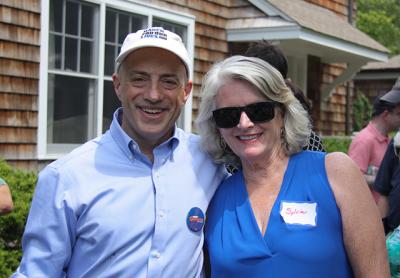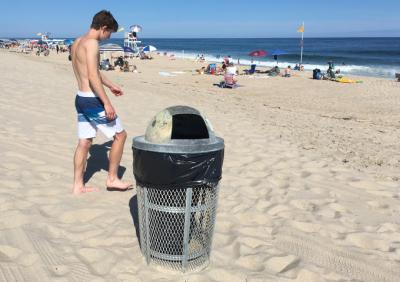Split Board Poised to Okay Easement
Split Board Poised to Okay Easement
The East Hampton Town Board is expected to narrowly vote in favor of granting an easement allowing Deepwater Wind to bury a transmission cable from its proposed South Fork Wind Farm on a path from Wainscott to a Long Island Power Authority substation off Cove Hollow Road in East Hampton.
An affirmative vote, which could come at the board’s meeting tonight, has been long awaited by Deepwater Wind, whose officials say they must have it before submitting applications to federal and state permitting agencies. But Councilman Jeffrey Bragman, in arguing against granting an easement at this time, told his colleagues that that assertion is unsupported by the facts, and that they should not feel pressured to grant the easement.
One by one, the five members of the board laid out a rationale for or against an easement when they met on Tuesday. While they expressed unanimous support for the concept of offshore wind, Mr. Bragman and Councilman David Lys said that Deepwater Wind has not been forthcoming with respect to several components of the project, particularly protection of fisheries and the livelihood of those who make their living on the water.
But for Supervisor Peter Van Scoyoc, Councilwoman Sylvia Overby, and Councilwoman Kathee Burke-Gonzalez, the transition from fossil fuels to renewable energy sources to combat climate change is too urgent to delay. “Later,” Ms. Overby said, “is too late.”
Local review of the proposed 15-turbine installation is “very, very limited,” Michael Sendlenski, the town’s lead attorney, told the board, but because Deepwater Wind wants to route the transmission cable under town-owned roadways, “only the town board, because of our property interest, our ownership of those roadways, has the ability to grant them an easement to go underneath those.” At issue before the board, he said, is “whether or not to grant that property interest right and easement under town roads, because we are pre-empted pursuant to the Article VII proceeding” — a review process under the state public service law covering applications to construct and operate a major electric transmission facility — “from taking on anything else.”
Article VII requires a review of the need for, and environmental impact of, the siting, design, construction, and operation of such facilities. Mr. Sendlenski suggested that the town file for Article VII intervener status with the State Public Service Commission, something the town trustees, who may have jurisdiction over the ocean beach in Wainscott at which Deepwater Wind wants to land the transmission cable, have indicated they will do.
Marguerite Wolffsohn, the town’s director of planning, detailed Deepwater Wind’s proposed community benefits package, an $8.45 million commitment to fund sustainability programs and infrastructure improvements in exchange for the easement, and summarized the 107 written comments received from the public following a May 17 joint hearing with the trustees, at which 49 people had spoken for or against the wind farm.
Should the board deny Deepwater Wind’s easement request, the company’s officials have indicated that they will seek to bypass it by landing the transmission cable on state-owned land at Napeague. But should the town accept the community benefits package, Deepwater Wind would not object to the town’s intervening in an Article VII review, said Joanne Pilgrim, executive assistant to Mr. Van Scoyoc.
“I still don’t feel this has been as complete an application as I’d like to see,” Mr. Lys said, while acknowledging that the effects of climate change — including sea level rise and the frequency and intensity of storms — are serious. He pointed to decisions he made while serving on the town’s zoning board of appeals to demonstrate his support for renewable energy, but said that mitigation plans should be in place to protect commercial fishermen, not only from loss of fishing gear but from diminished or eliminated catches due to unintended consequences of the wind farm. (Many opponents of the wind farm assert that the electromagnetic frequency emanating from the transmission cable may alter fish migration patterns, for example.)
Mr. Lys said that he has asked Deepwater Wind multiple times for such a plan, to be led by a third-party arbitrator. “This plan, in my opinion, would have multiple layers of continual research, not just for fisheries stocks, but information on landings.” Offshore wind “may be inevitable,” he said, and while he is in favor of the project, “not this application and community benefits package.”
“There seems to be an ominous silence from three members of the board,” Mr. Bragman said when Mr. Lys had finished speaking. A litany of reasons for voting against the granting of rights to Deepwater Wind followed, as he complained of “sporadic” presentations “and recitations of how well they managed other projects.”
“I’ve heard Deepwater Wind repeatedly claim . . . that they have to have us grant this right to begin their Article VII review,” Mr. Bragman said. “That is not an accurate statement. . . . They do not have to have us grant them this easement.” The company has been pressuring the board, he said. “I am uncomfortable that Deepwater Wind took that position and didn’t adequately explain it.”
Turning to his colleagues, he asked why they would even consider executing an “essentially permanent” real estate right before participating in an Article VII review. “Why are we committing ourselves before we do the environmental review? Once you’ve committed, you’ve given up a lot of your leverage. How much attention are they going to pay you when they can say the municipality is on board for the route?”
He is uneasy about accepting the community benefits package “before we begin, because it suggests it has something to do with the interest of getting this approved more quickly,” he said.
Moreover, he said, the wind farm is likely to produce more electricity in the winter months, when demand for electricity on the South Fork is low. “Our demand curve and supply curve are working in opposite seasons,” he said, and would encourage the construction of new fossil fuel-fired plants given the intermittent nature of wind power.
“I support wind power,” he said. “I also support a deliberative environmental review. My vote in this instance: Do not give this easement right. . . . Get active, hire experts to participate in Article VII. It does not come down to wind or fossil fuel.”
But “every megawatt generated in a clean and renewable way is one we don’t have to get from fossil fuel,” Mr. Van Scoyoc said. True, the cost of wind power is predicted to fall precipitously in the coming years, he said, just as the cost of flat-screen televisions did. “Does that mean we should wait? If everybody should take that approach — wait until costs come down — costs would never come down.”
The town can attach conditions to the granting of an easement, the supervisor said, “that would protect the town’s interests and retain leverage over the process. I fully believe the town should be the intervener, that we should go through the process supporting our fisheries and fisher-people in the town who have economic interests.” He is confident that further review by credentialed scientists and third parties through the Public Service Commission and the federal Bureau of Ocean Energy Management will mitigate any concerns, he said.
“Given present conditions here, with severe storms coming much more frequently, our coastlines being threatened, our quality of life at risk from outside impacts . . . we have to make a transition,” he said. “I think that the right approach would be to go forward with granting those easements with very strong language and retaining rights, and leaving them very much contingent” on thorough environmental review.
“From my perspective,” Ms. Burke-Gonzalez said, “there are real consequences to doing nothing, among them hotter temperatures, stronger and more frequent storms, and rising seas.” Granting the easement, and filing for Article VII intervener status “is going to offer us a meaningful opportunity for additional comment and mitigation,” she said.
Ms. Overby, the board’s liaison to the town’s energy sustainability advisory committee, said that solar power alone could not meet the town’s energy needs, as some of the wind farm’s opponents have suggested. “Reducing energy consumption, producing energy from renewable sources is needed now. Now is the time for leadership. It cannot be put off until later.”
However, she said, “Addressing and preserving the fishing industry must go hand in hand with our offshore wind power.” At least 25 percent of the carbon dioxide in the atmosphere goes into the ocean, causing its acidification, she said. “Because of the ocean acidification, food and jobs are profoundly affected.”
“Fishing is our sustainable industry here in East Hampton,” and the community benefits package would aid that sustainability, Ms. Overby said. “It’s necessary to do it now,” she said of the wind farm.




